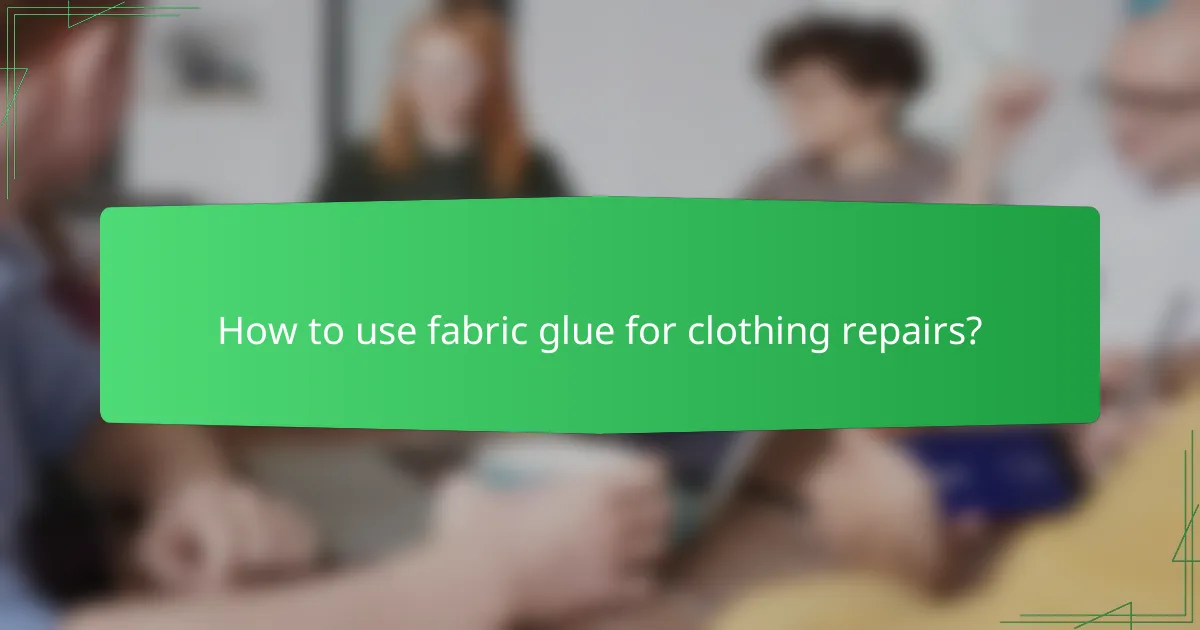Repairing plus size clothing is a valuable skill that can enhance the longevity and fit of your garments. By mastering basic sewing techniques, effective patching methods, and utilizing fabric glue, you can easily mend and revitalize your favorite pieces. With the right tools and knowledge, you can achieve professional-looking repairs that keep your wardrobe in top shape.

How to repair plus size clothing in Canada?
Repairing plus size clothing in Canada involves basic sewing skills, effective patching techniques, and the use of fabric glue. Understanding these methods can help extend the life of your garments and ensure a better fit.
Basic sewing techniques
Basic sewing techniques are essential for repairing plus size clothing. Start with hand sewing for small repairs like fixing seams or hems. A simple running stitch or backstitch can effectively mend tears and reinforce weak areas.
If you have access to a sewing machine, consider using a straight stitch for seams and a zigzag stitch for stretch fabrics. Always test your stitches on a scrap piece of fabric to ensure the tension is correct.
Patching methods
Patching is a practical way to repair larger holes or worn areas in plus size clothing. Begin by selecting a fabric that closely matches the original garment in weight and texture. Cut a patch that extends at least an inch beyond the damaged area.
Position the patch under the hole and secure it with pins. You can sew it in place using a straight stitch or a zigzag stitch for added durability. For a more polished look, consider using a decorative stitch or contrasting thread.
Using fabric glue
Fabric glue is a quick and effective alternative for repairing plus size clothing without sewing. It works well for hems, small tears, or attaching patches. Ensure the fabric is clean and dry before applying the glue.
Apply a thin layer of fabric glue to the edges of the fabric or patch, press firmly, and allow it to dry according to the manufacturer’s instructions. Keep in mind that fabric glue may not be as durable as sewing, so use it for less stressed areas.
Choosing the right thread
Selecting the right thread is crucial for successful repairs on plus size clothing. Use polyester thread for its strength and flexibility, which works well with most fabrics. For natural fabrics like cotton or linen, opt for cotton thread to maintain a consistent look.
Ensure the thread color matches your fabric closely to make repairs less noticeable. If you’re working with stretchy fabrics, consider using a specialty thread designed for elastic materials to prevent breakage.
Finding suitable fabrics
When repairing plus size clothing, finding suitable fabrics is key to achieving a seamless look. Look for fabrics that are similar in weight and stretch to the original garment. Common options include cotton blends, jersey, and spandex.
Visit local fabric stores in Canada to explore a variety of options. Many stores offer swatches, allowing you to compare textures and colors before making a decision. Always pre-wash new fabrics to prevent shrinkage after repairs.

What sewing tools are essential for repairs?
Essential sewing tools for repairs include a sewing machine, hand sewing tools, fabric scissors, and measuring tools. These items will help you efficiently fix plus size clothing, ensuring durability and a professional finish.
Sewing machine recommendations
A reliable sewing machine is crucial for quick and effective clothing repairs. Look for machines that offer a variety of stitch options, including zigzag and straight stitches, which are useful for different fabric types and repair techniques.
Popular brands like Brother and Singer provide models that are user-friendly and suitable for beginners. Consider machines that come with built-in tutorials or automatic features to simplify the sewing process.
Hand sewing tools
Hand sewing tools are essential for small repairs and detailed work. A basic toolkit should include needles of various sizes, a thimble for protection, and a selection of threads that match your fabric colors.
Investing in a needle threader can save time and frustration, especially with finer threads. Always keep a small pair of scissors handy for trimming loose threads and making precise cuts.
Fabric scissors
Quality fabric scissors are vital for clean cuts and preventing fraying. Choose scissors specifically designed for fabric, as they provide sharper edges and are less likely to snag the material.
Keep your fabric scissors separate from other household scissors to maintain their sharpness. Regularly sharpen them to ensure they cut smoothly, which will make your repairs easier and more precise.
Measuring tools
Accurate measurements are key to successful repairs. A flexible measuring tape is ideal for taking body measurements and checking fabric lengths, while a clear ruler can help with straight edges and hems.
Consider using a seam gauge for smaller adjustments, as it allows for precise measurements of hems and seam allowances. Always double-check your measurements before cutting or sewing to avoid mistakes.

What are effective patching techniques for plus size clothing?
Effective patching techniques for plus size clothing include using iron-on patches, fabric patching methods, and fusible interfacing. Each technique offers unique benefits and can be chosen based on the fabric type and the extent of the damage.
Iron-on patches
Iron-on patches are a quick and easy solution for repairing plus size clothing. These patches come with a heat-activated adhesive on one side, allowing you to simply place them over the damaged area and apply heat with an iron to secure them in place.
When using iron-on patches, ensure the fabric is clean and dry. Choose a patch that closely matches the fabric color and texture for a seamless look. Avoid using iron-on patches on stretchy fabrics, as they may not adhere well and can cause distortion.
Fabric patching methods
Fabric patching methods involve sewing a piece of fabric over the damaged area. This technique is particularly effective for larger holes or tears and allows for creative expression by using contrasting or decorative fabrics.
To patch effectively, cut a patch that extends at least an inch beyond the damage on all sides. Use a sewing machine or hand stitch to secure the patch, ensuring the edges are well-finished to prevent fraying. Consider using a zigzag stitch for added durability.
Using fusible interfacing
Fusible interfacing is a versatile option for reinforcing fabric and repairing damaged areas. This material adheres to the back of the fabric when heat is applied, providing extra strength and stability.
To use fusible interfacing, cut a piece slightly larger than the damaged area and place it on the reverse side of the fabric. Apply heat with an iron according to the manufacturer’s instructions. This method is ideal for lightweight fabrics and can help prevent further tearing.

How to use fabric glue for clothing repairs?
Fabric glue is an effective solution for quick clothing repairs, especially for plus size garments. It bonds fabric pieces together without the need for sewing, making it ideal for patching holes or securing hems.
Types of fabric glue
There are several types of fabric glue available, each suited for different materials and purposes. Water-based fabric glue is easy to clean and dries clear, making it a popular choice for lightweight fabrics. For heavier materials, such as denim or canvas, a stronger, industrial-grade fabric adhesive is recommended.
Some fabric glues are designed to be washable and dry flexible, which is essential for clothing that will be worn regularly. Always check the label for specific fabric compatibility and washing instructions to ensure durability.
Application techniques
When applying fabric glue, start by cleaning the fabric surfaces to remove any dirt or oils. Use a thin, even layer of glue on one side of the fabric, and press the pieces together firmly. For best results, use a toothpick or a small brush to apply the glue precisely, avoiding excess that can seep out.
For larger repairs, consider using a fabric patch. Cut the patch slightly larger than the damaged area, apply glue to the patch, and press it onto the fabric. Use clips or weights to hold it in place while it dries.
Drying times and care
Drying times for fabric glue can vary, but most types require at least 24 hours to cure completely. It’s advisable to avoid washing the garment for at least 72 hours after application to ensure a strong bond. Always refer to the manufacturer’s instructions for specific drying times.
When caring for glued fabrics, wash them in cold water on a gentle cycle and air dry whenever possible. Avoid using bleach or fabric softeners, as these can weaken the adhesive bond over time.
